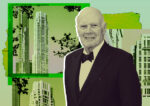Trending
How risqué ads promote new projects
Some real estate ads shouldn’t be left lying on a coffee table when there are young children around.
That’s because real estate developers know sex sells — and they are increasingly marketing their projects with explicit sexual images, or at least sexual undertones, even at the risk of offending older buyers.
Spicy advertising has picked up in frequency in New York City in the last few years, as the number of units coming online has increased and developers have sought ways to distinguish themselves.
At the William Beaver House in the Financial District, there was a backlash against ads that were deemed too racy. The majority of the sales at the development were concluded after the sex-infused ads were abandoned.
Now, the Platinum, District, Forté Condominiums and 100 West 18th Street are a few new developments using sexy images in their advertising materials; whether or not they are in good taste is a matter of debate.
Marketers and developers describe their sexy ads as “playful,” mirroring “the feel of the building” and telling a “story.”
Real estate pros have different reactions to their competitors’ ads, some calling them “hot” while others said “cheesy,” a “turnoff” and not “sophisticated.” Some called the ads a cop-out used to cover up a bad project, while at the same time admitting to using sex in their own ads at one time or another.
But the proof is in the risquely dressed pudding: The buildings that use sex seem to sell.
Testing their mettle
Ads for the Platinum, at 247 West 46th Street and Eighth Avenue, show platinum-painted bodies in bathing suits of the same color that appear painted on them. They are actually doctored versions of nude pictures originally taken by photographer Guido Argentini.
“Our whole idea was they were strong,” said Martin Brady, vice president of sales for the Marketing Directors Inc., the exclusive sales and marketing agent for the Platinum. “They were perfect bodies. They were powerful. That was our image of the building.”
Adding the swimsuits, said Ronald Nelson of Sherman Advertising Associates, which designed the ads, “took the emphasis off the sexiness, if you will, and put the emphasis on muscularness.”
One marketing expert with no connection to the project, who asked not to be named, said the ads were “inappropriate for the New York market,” and were “better suited” for South Beach, where blatant sexuality is used to advertise real estate.
It may not be South Beach, but the ads are selling a building on a block in Times Square that was once known for a different kind of sex trade. The Platinum is located on a block that houses two porn shops, vestiges of the once-rough Hell’s Kitchen.
Although it is difficult to gauge an ad’s effectiveness, the pace of sales provides some indication: Six months into sales, the building hit the 60 percent sold-out mark.
The building, which has 220 units, from studios to three-bedrooms, has prices up to $7.5 million. Comedian Rosie O’Donnell has reportedly bought in the building.
Risqué ads were also used to brand the District, a Leviev Fulton Club building at 60 Ann Street Downtown.
In one ad, a beautiful couple is standing in front of a window; he is in an unbuttoned shirt, and she is standing in the background in a black dress. The slogan: “Smart. Sexy. Available.”
Scott Aaron, director of development for the Brauser Group, which is not involved with District, considers the ads “hot.”
“It’s nice to see something other than a building and a tagline on top of it,” Aaron said. “I love anything I haven’t seen before that is creative and outside the box.”
Nikki Martin of JC DeNiro & Associates, director of sales and marketing for District, wrote in an e-mail, “The building is incredibly chic. We are using creative language and suggestive images in our marketing and advertising that will reflect the style of this project.”
What makes using sex-related images particularly risky is that they may appeal to a certain population, like younger buyers, while alienating others, especially older buyers, who often are the ones who can afford to buy the units.
One agent said she took a couple to the District sales office and “it was so blatantly sexual — and the woman was totally insulted and turned off.”
If a developer builds a quality building, why resort to sex?
“We are not using sex to sell,” Martin said, adding, “Our photos definitely capture the appeal of living in New York City, and also focus on telling the story of an attractive couple in their life Downtown, hinting at what life would be like at District.”
Since sales began at District in June, units are being snapped up. In six months, 70 percent of the units were taken. Units range from $525,000 to $2.15 million.
Of the District ads, Clifford Finn, managing director of new development marketing at Citi Habitats, said, “I think it would have sold just as well if they didn’t go for the sex, because it’s a nice building.”
Sometimes it’s the text, more than the images, that ratchets up the risqué factor.
An ad for the Forté Condominiums, a Fort Greene development by the Clarett Group, features a man and a woman in bathing suit bottoms, from the waist down, lying on their stomachs on chaises, with a view of Manhattan behind them. The headline reads: “Now that’s what I call a view.”
“We wanted to use something sexy that grabbed your attention. It was a play on words,” said David Perry, director of sales and marketing for the Clarett Group. “This was enough to highlight the view.”
One competitor characterized the ad as “cheesy” and “wrong for New York City.”
In the first two months since the sales office opened, after the building was already completed, Clarett sold 20 percent of its 108 units, 65 percent of which are two-bedroom units. Prices start at $575,000 and go up to $1.3 million.
Back in Manhattan, the Brauser Group is marketing 100 West 18th Street with a series of ads, one of which displays a woman lying on her back on a bed, in a short black dress and fishnet stockings.
Aaron of the Brauser Group acknowledged that the ads were sexy but said there was a reason for it other than sex appeal.
“It’s sexy in terms of its edginess. The ads mirror the feel of the building,” Aaron said.
But unlike some other pros who contend that they would use their sex-infused ads anywhere in the city, he said that he would not have used the 100 West 18th Street ads elsewhere in Manhattan.
“If I was marketing a building on the Upper East Side, I would certainly use more family-oriented images with families and dogs and things like that,” Aaron said.
In the seven months since sales started, 65 percent of the 43 units at 100 West 18th Street have sold.
Too sexy for the market?
Perhaps the ad campaign that caused the greatest stir in the media was the Corcoran Sunshine Marketing Group’s approach to Andre Balazs’ William Beaver House, at the corner of William and Beaver streets. The ads showed a cartoon beaver and barely clothed cartoon characters living it up.
The hotelier said the beaver ads were not over the top.
“I personally am not sure it was sexy,” Balazs said.
The point of the beaver character was “to establish the name and persona of the building.”
Balazs then traded that sex-infused marketing campaign (and its creators) for ads with virtually no people — and he switched to another marketing group. Balazs said the revamping was solely due to a shifting demographic.
The marketers are repositioning the building for a “much more upscale, and different, market,” he said. It is supposed to reflect that “it’s the ultimate Downtown address,” Balazs added.
Sales officially began in mid-January, and as of the middle of last month, the 258-unit, 47-story building was more than 60 percent sold, Balazs said.
Core Group Marketing took over for Corcoran Sunshine June 15, and the majority of sales were concluded after that date, said Shaun Osher, founder and CEO of Core.
Selma Nasser Langer, director of public relations and advertising for Corcoran Sunshine, said the company had no comment and directed future inquiries about William Beaver House to Core.
Balazs, meanwhile, keeps besting his own price records in the building, selling the second of three penthouse units last month for $5.7 million, or $3,512 a square foot. That was believed to be the highest per-square-foot price for a one-unit sale Downtown.
Double-edged sword
Real estate practitioners may be scorning the practice of running sexy ads, but they are also using it.
Citi Habitats’ Finn, for example, said that for the most part, “I don’t go that route. I don’t like to cheapen the credibility of a developer, and I like a building to stand on its own merits … but I can’t say I never gave it a shot.”
In 2005, Citi Habitats advertised the condo conversion of Herald Towers, at 50 West 34th Street, using sexual innuendo. One of the images displayed a woman sitting atop a shirtless man’s back.
The caption reads: “Go ahead, be as loud as you want. But only if you live in Herald Towers, where the walls are thick…”
“We chose one or two playful ads that sort of used that tongue-in-cheek, double-entendre sexiness of a couple in their bedroom,” Finn said. “It had a point. It wasn’t just trying to be sexy just to have a sex ad.”
The building, he said, was a tough sell because of its large size and non-residential location, and the marketers were trying to emphasize the value of a prewar building.
“It got a lot of people noticing it,” Finn said. In the end, however, the condominium conversion plan was abandoned due to a conflict among the owners.
Too much sex sometimes makes brokers question whether they are being used to compensate for a poorly designed product.
“When a project’s marketing centers around sexual innuendo, I think buyers should beware,” said Erin Boisson Aries, a senior vice president and managing director at Brown Harris Stevens. “The message it sends to brokers and buyers is that it’s being used in order to cover up the building’s shortcomings.”
Some real estate pros said perspective also depends on location.
Elizabeth Stribling, president of Stribling & Associates, said her company did a brochure for the Smyth, a building on West Broadway in Tribeca, that “had a sexy image to it” and was “pushing the envelope.”
But that was nothing compared to when her firm started exploring marketing options for condos in The Plaza Hotel two years ago. The firm was inundated with many sex-infused pitches from Florida marketers.
“It just seemed so foreign to the sophisticated New York market,” Stribling said. “New Yorkers are not so much interested in lifestyle and sexy images as they are in the foundation, the substance, the quality.”
Sex, Stribling added, “may make it noticeable, but I don’t think it sells apartments. I think a lot of people notice things they don’t like.”




